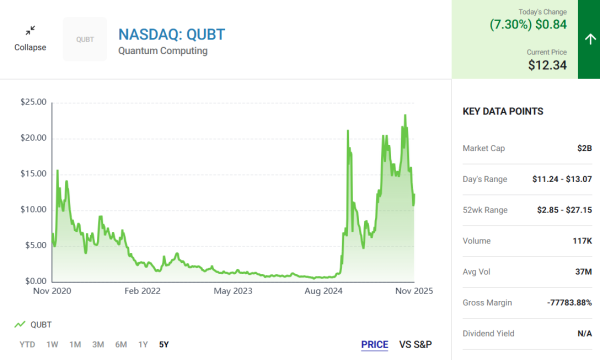Brokers from Logirium dive into the rapidly evolving world of quantum computing, examining whether Quantum Computing Inc. (QUBT), also known as QCi, represents a compelling investment opportunity today.
Over the past year, quantum computing stocks have captured significant investor attention, with QCi experiencing substantial share price appreciation. Yet, while the technology shows enormous promise, the company’s current fundamentals raise questions about the prudence of buying its stock at this time..
Quantum Computing Inc.’s Technological Edge
At the heart of QCi’s appeal is its use of photons to power quantum computers. Unlike other quantum approaches, such as superconducting qubits used by larger competitors like IBM, photonic technology enables QCi’s machines to operate at room temperature and supports the miniaturization of components.
Photons can also carry quantum information over long distances at the speed of light, a key advantage for networking quantum systems without additional infrastructure.
These unique features make QCi’s technology suitable for real-world applications, such as integration into consumer devices and self-driving vehicles. Indeed, the company sold one of its quantum computers to a major automotive manufacturer this year, signaling early commercial traction.
Photonic sensors can process real-time driving conditions with remarkable speed, demonstrating practical benefits for dynamic industries like automotive and robotics.

Revenue Growth Amid High Costs
Despite these technological advantages, QCi faces the typical challenges of a nascent industry. Controlling photons in calculations is complex, and errors require expensive and time-consuming corrections. Consequently, quantum computing remains costly compared to conventional computers.
In the third quarter, QCi generated $384,000 in revenue, up from $101,000 a year earlier, marking a more than threefold increase. While this growth is promising, it remains modest compared to the company’s rising costs, which nearly doubled to $10.5 million. This disparity highlights the high-risk nature of the business, where operational expenses vastly outpace income.
Financial Cushion Provides Breathing Room
Fortunately, QCi secured significant funding to sustain operations and expand its technological capabilities. An equity offering in October raised $750 million, and combined with cash and investments of $813 million, the company now holds over $1.5 billion to fuel growth. This financial runway gives QCi time to improve product adoption, refine its technology, and potentially scale revenue without the immediate pressure of insolvency.
While QCi’s revenue is still small, the company’s cash reserves provide a safety buffer, allowing it to continue innovating in the photonic quantum computing space. This positions QCi to potentially capitalize on growing market demand as commercial applications of quantum technology expand.
Valuation Concerns and Market Hype
A critical consideration for investors is QCi’s current stock valuation. Despite early revenue growth, the company’s forward price-to-sales (P/S) ratio remains extremely high, reflecting investor excitement over the potential of photonic quantum computers rather than underlying financial performance.
By comparison, IBM, a mature technology firm with established revenue streams, trades at a P/S ratio of around 4, illustrating the speculative nature of QCi’s stock.
This disparity suggests that much of the share price appreciation over the last year is driven by market enthusiasm for the quantum computing sector and its applications in AI and high-performance computing, rather than immediate operational success. Investors buying at current levels are taking on high risk, betting on future adoption and breakthroughs in a highly experimental field.
Is Now the Time to Buy?
Given the company’s modest revenue, rising costs, and sky-high valuation, purchasing QCi stock today is a speculative move. While the photonic technology holds significant long-term potential, the financials indicate that it is not yet a reliable growth engine capable of justifying the current stock price.
That said, QCi warrants attention from investors who want exposure to quantum computing. Monitoring its commercial partnerships, product adoption, and revenue growth over the next few quarters will provide clearer signals regarding its viability as an investment. For now, placing the stock on a watch list and closely tracking its progress is a prudent approach.
Conclusion
Quantum Computing Inc. exemplifies the high-risk, high-reward nature of investing in emerging technologies. Its photon-based quantum computers offer practical advantages and early commercial applications, signaling potential for future market impact. Yet, the current financial metrics, low revenue, escalating costs, and an inflated stock price make buying now a speculative venture.
Analysts advise that investors maintain cautious optimism: monitor technological adoption and financial performance, but avoid committing substantial capital until the company demonstrates sustained revenue growth.
In summary, QCi remains one of the most intriguing pure-play quantum computing stocks, offering a glimpse into the future of computing. Investors with a high-risk tolerance may follow the stock closely, but a disciplined approach, watching for tangible milestones, is essential before making a purchase.








